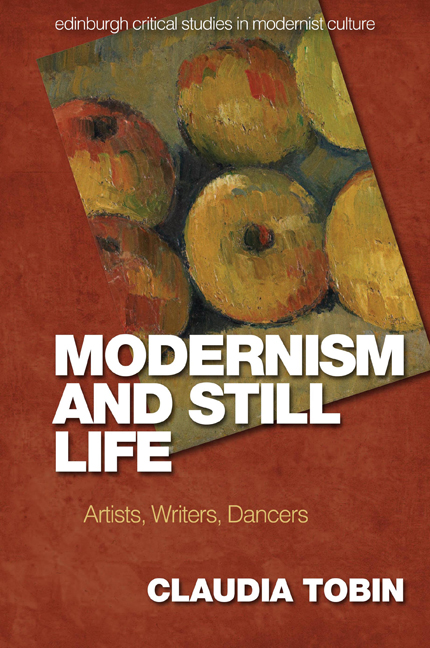Book contents
- Frontmatter
- Contents
- List of Figures and Plates
- List of Abbreviations
- Acknowledgements
- Series Editors’ Preface
- Introduction: ‘Nothing is really statically at rest’: Cézanne and Modern Still Life
- 1 ‘Quivering yet still’: Virginia Woolf, Roger Fry and the Aesthetics of Attention
- 2 Still Life in Motion
- 3 ‘Past the gap where we cannot see’: Still Life and the ‘Numinous’ in British Painting of the 1920s–1930s
- 4 ‘Inactive contemplation’: Wallace Stevens and Charles Mauron
- Conclusion: ‘On the very brink of utterance’: Aldous Huxley, Mark Gertler and Transfigured Things
- Bibliography
- Index
- Plate Section
2 - Still Life in Motion
Published online by Cambridge University Press: 08 October 2020
- Frontmatter
- Contents
- List of Figures and Plates
- List of Abbreviations
- Acknowledgements
- Series Editors’ Preface
- Introduction: ‘Nothing is really statically at rest’: Cézanne and Modern Still Life
- 1 ‘Quivering yet still’: Virginia Woolf, Roger Fry and the Aesthetics of Attention
- 2 Still Life in Motion
- 3 ‘Past the gap where we cannot see’: Still Life and the ‘Numinous’ in British Painting of the 1920s–1930s
- 4 ‘Inactive contemplation’: Wallace Stevens and Charles Mauron
- Conclusion: ‘On the very brink of utterance’: Aldous Huxley, Mark Gertler and Transfigured Things
- Bibliography
- Index
- Plate Section
Summary
It has been realized in painting that a still life, of the most ordinary objects, may be (and usually is) a far greater work of art than an enormous painting of some great historic event full of kings and queens! It is time that this was realized in relation to the stage.
Margaret MorrisMovement practices in the early twentieth century reveal a fascination with the relationship between stasis and motion, and the fluidity of these apparent polarities. When the pioneering dancer Margaret Morris sought to define her movement technique in an article of 1917, published in Arts and Letters alongside illustrations by Gaudier-Brzeska and J. D. Fergusson, she deployed but also complicated the longstanding binary of visual art and dance. ‘I look at dancing from the visual point of view of the artist,’ Morris writes, ‘seeing movements as combinations of shapes and lines, and ballets as pictures with the possibilities of actual movement added.‘ She foregrounds the static image as the source of her vision for dance, with gesture and movement as a translation of the drawn line. This intimate alliance between dance and painting was fundamental to her practice and it takes us to the heart of this chapter‘s inquiry.
Lynda Nead suggests that at the turn of the twentieth century the development of visual technologies rendered the still image ‘a conceptual impossibility’ at a time when scientific research was proving all bodies to be in a state of relative rest and movement, and psychologists of perception were revealing ‘constant muscular activity’ in the eye and nervous system. If stillness was ‘refuted as a property of the image, the object and the beholder’, as Nead suggests, then one might ask what place it could have in movement practices of the period? Through case studies of two European movement practices, this chapter explores the ways in which movement had the potential to encompass subtle scales of motion, including the manifestation of stillness in the body as a performance in its own right. As I suggest more widely in this book, the cultural potency of animation indicated not simply an attraction to speed, but rather to varied forms of motion and arrest – ‘diverse velocities’ – in Nead's useful phrase, which re-imagined the relationship between the ‘static’ and ‘mobile’ arts.
- Type
- Chapter
- Information
- Modernism and Still LifeArtists, Writers, Dancers, pp. 76 - 123Publisher: Edinburgh University PressPrint publication year: 2020



